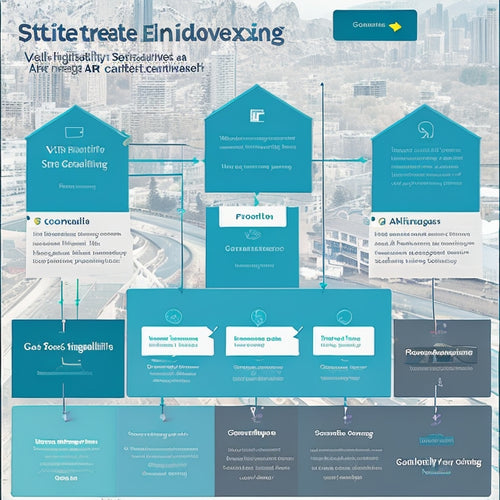
Supply Chain and Business Strategy Converge Ahead
Share
As e-commerce and logistics converge, businesses must adapt by integrating supply chain operations into their overall strategy. The pandemic's lasting effects on omnichannel retail and 3PL growth necessitate a harmonized approach, synchronizing logistics, operations, and commercial goals. The blurring of traditional supply chain structures calls for strategic partnerships, agility, and resilience. With implications on costs, supply chain structures, and relationships, prioritizing supply chain considerations in business strategy is essential. As the landscape continues to shift, understanding the intricacies of this convergence will be critical for businesses to stay ahead, and exploring these complexities will reveal the key to opening long-term success.
Key Takeaways
• As e-commerce and 3PL converge, businesses must integrate logistics into their overall business strategy to stay competitive.
• A harmonized approach synchronizes logistics, operations, and commercial goals, prioritizing supply chain considerations in business strategy.
• Merging strategies enables companies to adapt to demand patterns, build resilience, and respond to market conditions with innovative solutions.
• Supply chain flexibility is crucial to respond to changing market conditions, and businesses must rethink traditional supply chain structures to achieve it.
• Convergence of supply chain and business strategy necessitates a fundamental shift in operations, prioritizing agility, resilience, and strategic partnerships.
E-commerce and 3PL Convergence
As the e-commerce landscape continues to evolve, the once-distinct lines between e-commerce and third-party logistics (3PL) are increasingly blurring, with retailers like Amazon, Walmart, and Zalando pioneering FBA-like models that redefine the role of logistics in online retail.
This convergence is driven by the need for supply chain optimization, as e-commerce growth demands more efficient and effective logistics solutions. By integrating 3PL capabilities, retailers can improve delivery speed, reduce costs, and enhance the overall customer experience.
As a result, e-commerce players are transforming into logistics powerhouses, leveraging their scale and expertise to drive growth and profitability. This trend is likely to continue, with retailers investing heavily in logistics infrastructure and technology to stay ahead in the competitive e-commerce landscape.
Distribution Models' Impact
The proliferation of FBA-like distribution models is having a profound impact on working capital, inventory levels, and operational complexity, forcing retailers to reassess their logistics strategies and investments.
As online retailers leverage FBA-like models, inventory levels surge, leading to increased working capital requirements. This, in turn, adds complexity to operations, making inventory management a critical concern. Working capital fluctuations become more pronounced, and retailers must adapt to mitigate the risks.
To stay competitive, retailers must reassess their distribution models, investing in agile and responsive logistics strategies that can handle the nuances of e-commerce. By doing so, they can navigate the complexities of modern retail and stay ahead of the curve.
Pandemic's Lasting Effects
Beyond the initial shock, the pandemic's lasting effects on e-commerce and 3PL are evident in a permanent shift towards omnichannel retail, with online sales surging and 3PL global revenue growing exponentially.
As we navigate this new landscape, it's evident that supply chain disruptions will continue to be a major pain point. With labor market tightness influencing 3PL growth, companies must adapt to meet the evolving demands of their customers.
The pandemic has accelerated the shift to omnichannel retail, and businesses must now focus on building resilience strategies to mitigate future challenges. As we look to the future, it's essential to prioritize supply chain considerations in business strategy, lest we face even more severe disruptions down the line.
Adapting to New Realities
E-commerce and 3PL growth have converged, necessitating a fundamental shift in how businesses approach their supply chain operations to guarantee long-term sustainability and competitiveness.
The pandemic has accelerated this convergence, exposing the need for supply chain flexibility to adapt to shifting demand patterns. Businesses must now prioritize strategic partnerships to secure agility and resilience in their operations.
This means rethinking traditional supply chain structures and embracing innovative solutions that can respond to changing market conditions. By doing so, companies can not only survive but thrive in this new reality, where supply chain and business strategy are inextricably linked.
As the landscape continues to evolve, those that adapt will be the ones to reap the benefits of this convergence.
Merging Strategies Ahead
As supply chain and business strategy increasingly converge, companies must pivot towards a harmonized approach that synchronizes logistics, operations, and commercial goals to stay competitive in the rapidly evolving market landscape.
This strategy convergence marks a significant shift, where business strategy and supply chain operations become inextricably linked. The future implications of this convergence are far-reaching, with repercussions on costs, supply chain structures, and the blurring of lines between manufacturers, 3PL providers, and customers.
As companies adapt to this new reality, they must prioritize supply chain considerations in their business strategy to stay ahead of the curve.
The question is, are you ready to merge your strategies ahead and reap the benefits of a harmonized approach?
Frequently Asked Questions
How Do Manufacturers Benefit From Partnering With 3PL Providers Like Zalando?
Manufacturers partnering with 3PL providers like Zalando can reap benefits from efficiency gains through streamlined logistics and cost savings from reduced inventory holding and transportation costs, ultimately enhancing their competitive edge in the e-commerce landscape.
Can Fba-Like Models Be Replicated by Traditional Logistics Providers?
As the phoenix rises from the ashes, traditional logistics providers can replicate FBA-like models by embracing logistics innovation, adapting to evolving consumer demands, and investing in scalable, agile operations to stay ahead of the curve.
What Role Will Artificial Intelligence Play in Future Supply Chain Management?
As AI integration revolutionizes supply chain management, predictive analytics will optimize inventory levels, streamline logistics, and enhance customer experiences, allowing businesses to stay ahead of the curve and capitalize on emerging trends with precision and agility.
How Will the Growth of E-Commerce Impact Urban Logistics and Infrastructure?
With online sales surging 61% in the US post-pandemic, urban logistics and infrastructure face unprecedented pressure. To mitigate last mile challenges and congestion, e-commerce growth demands innovative, sustainable solutions prioritizing efficiency, such as micro-fulfillment centers and green delivery fleets.
Will Increased Inventory Levels Lead to More Product Customization Options?
As inventory levels rise, customization potential increases, driven by demand forecasting and product variety. This shift enables businesses to offer tailored products, fostering loyalty and driving revenue, while also presenting opportunities for innovative logistics and supply chain management strategies.
Related Posts
-
Ultimate Guide To Creator Platforms For High-Performing Ugc Videos
Welcome to the ultimate guide to creator platforms for high-performing UGC videos. In this comprehensive article, we ...
-

What Are the Benefits of Sitemaps for SEO
Sitemaps play a crucial role in search engine optimization (SEO) by enhancing website visibility and improving ranki...
-

Content Shopify Apps Aid Merchants in Creating and Managing Diverse Store Content
This article discusses the benefits of using Shopify apps for content management in order to aid merchants in creati...

